
18 minute read
Maddux Cattle Company
Focused on long-term success by applying Wall Street strategies to ranching
By Kindra Gordon
Advertisement
“ We run our ranch more like a hedge fund than we do a ranch,” says John Maddux, of his family’s ranching enterprise – Maddux Cattle Company – headquartered in southwest Nebraska near Imperial.
As the fourth generation of Madduxes to operate and manage the large cow/calf and yearling operation across 45,000 acres of deeded and leased land, Maddux brings a unique Wall Street perspective to the ranching table.
Raised in Nebraska with a passion for the family’s cattle operation, John’s parents Jack and Carol encouraged him to further his education and learn more about business and finance. To that end, he spent 15 years away earning an MBA at The University of Chicago and then working for Goldman Sachs – in Chicago and New York City – in investment banking specializing in bonds.
“It was a different kind of environment and a very intense experience working on a trading desk, but I enjoyed it,” says Maddux, who returned to Nebraska in 1998. Today, he and wife Julia along with their two sons, Taylor and Tomas, and a team of ranch staff are shepherding the 136-year-old family business into the future – and Maddux has had an opportunity to apply his Wall Street experiences to that effort.
Maddux notes, “What I learned and brought back ironically wasn’t necessarily new, as much as lessons I already learned from my grandparents and parents.” He continues, “The basic fundamentals of our business and the way we operate were already on our ranch, but the experiences that I gathered on Wall Street put an exclamation point on our approach to ranch management when I came back.”
Focused On Efficiency
Maddux credits the three generations before him for their foundational roles in establishing, growing and maintaining the ranch. This includes Taylor and Clara Maddux who homesteaded the original ranch in 1886 eleven miles north of Wauneta, Neb.; Glen and Eva Maddux – John’s grandparents; and his parents Carol and the late Jack Maddux. John shares that his mom Carol is still an important contributor to ranch discussions and decisions today.
Maddux Cattle Company’s core business enterprises include 2,500 cows, as well as grazing and marketing 5,000 to 6,000 yearlings every year. The yearling operation spans grazing arrangements in Nebraska, Wyoming and several other states, while the cowherd is primarily based in Nebraska. Maddux cows are unique in that a five-breed composite population of “Maternalizers” were developed in order to capitalize on benefits of hybrid vigor and to emphasize maternal traits. The composite includes: 3/8 Red Angus, 1/4 Tarentaise, 1/8 Red Poll, 1/8 South Devon, and 1/8 Devon.
Maddux says Maternalizer females are well suited for their Western Nebraska environment and production system. The cows are smaller framed and easy fleshing, with desirable udders. Maddux’s focus is on cows that can be maintained through yearround grazing with minimal – if any – supplemental feed and the ability to deliver low birth weight calves without assistance.
With those fundamentals in place, Maddux believes the rest of the business boils down to a financial mindset.
Financial Strategies
Among his strategies are six core principles that were emphasized at Goldman Sachs, and Maddux is now applying to ranch management.
Focus on Cost of Capital. Maddux tells, “At Goldman Sachs we had billions of dollars’ worth of securities that we were carrying, and it was all done with leverage. As a result, there was an intense focus to make sure everything we purchased had to return the cost of capital plus something.” He adds, “My dad and grandparents knew this lesson, but my Wall Street experience reinforced this to me – that every dollar on the ranch has to bring back a premium over the cost of capital.”
Examine Capital Structure. “The ranching business is not one that can support a tremendous amount of debt,” notes Maddux. Thus, he strives to regularly evaluate if the ranch has a manageable amount of debt to equity. As well, he says, “Being from the bond business, I’m always focused on aggressively managing our fixed rate versus variable rate financing.” Doing so he points out, helps a business avoid being subject to rising interest rates like what is currently occurring.
Seek Diversification. “One of the important aspects of portfolio management is diversification,” says Maddux, who explains that having assets that offset the movement in other assets is key to this strategy. He notes that a traditional ranch like his parents and grandparents ran had basic assets of land and cattle. But today, ranch managers have opportunities to diversify with a mix of financial assets along with livestock and land. Maddux points to PRF (Pasture, Range & Forage)

Insurance as one example, and says, “PRF insurance is more of an investment than it is insurance. It is based on the weather, which makes it a wonderful diversifier [to offset traditional ranch assets] in a portfolio.”

Manage Risk. Maddux notes, “At Goldman Sachs we were active risk managers in the bond market, and I’d say similarly ranching is a risky business. We do need to take some risks, because we want to have outsized returns on occasion.” But along with that, he emphasizes it is essential to have a written plan that gives “permission to act.” He explains, “Having that plan is super important because when you get caught up in the market your plan will help you act and allow you to pull the trigger at a time when human nature says, ‘Why would I do that because the market has been going straight up?’ But having that plan takes the emotion and human nature of questioning ‘What if I’m wrong?’ out of the decision.”
Additionally, Maddux cautions against lack of action. He notes, “Doing nothing and passively waiting for something to happen is not riskless. Don’t let fear of the future cause inertia to drive your risk management strategy.”
Recognize Depreciation. “Cows are a very strange capital asset,” Maddux points out, and explains that as a cow is developed and brought into the herd she appreciates until she is 6-years-old, and then there is a very rapid depreciation after that point – with depreciation considered the second highest expense in raising a cow. So, Maddux has developed a strategy to take advantage of this timeline and minimize depreciation. Maddux Cattle Company focuses on low-cost, forage-based heifer development, with almost all heifers returning to the herd as breds. Maddux says, “This allows us to build a large volume of functional running age cows.” Consequently, in April a cow sale is held offering 5- and 6-year-old cows from the herd.
Maddux says, “This ensures we are selling that cow at her optimum value right before she depreciates in a huge way.” Combined with bringing in heifers at a low-cost, Maddux believes this strategy eliminates depreciation within his cowherd on the ranch balance sheet.
Cultivate Culture Within Your Team. Maddux says, “I have learned the power of culture from shared values among the people on our ranch team.” He recognizes the “tribal knowledge,” pride, and team effort that emerges when people genuinely enjoy their role and the pursuit of contributing toward the business goals, rather than solely viewing their job as trading time for money. Maddux credits the three generations before him for fostering a team approach and building the Maddux ranch “culture.”
Similarly, while at Goldman Sachs, Maddux valued the culture that was established and epitomized by the guidance of senior partner, Gus Levy, who was known for saying, “Boys, we want to be long-term greedy.” Throughout his ranch tenure, Maddux has strived to keep this watch phrase top-of-mind because it captures the family’s long-term intentions to encompass the importance of integrity and valuing customer relationships over short term profits.
Maddux shares, “The idea of short term versus long term is applicable to us and one we live by every day.” He notes that ranchers can’t cut corners for short term gains in range management, cattle nutrition, or their relationships with people be it employees, colleagues or customers.

Ultimately, Maddux credits people as a key ingredient to any business’ success, and strives to recruit, train and retain employees as a long-term investment. Maddux concludes, “Having a ranch where employees have a strong sense of purpose and culture in order to help pass that culture on to others is truly the definition of riding for the brand.”
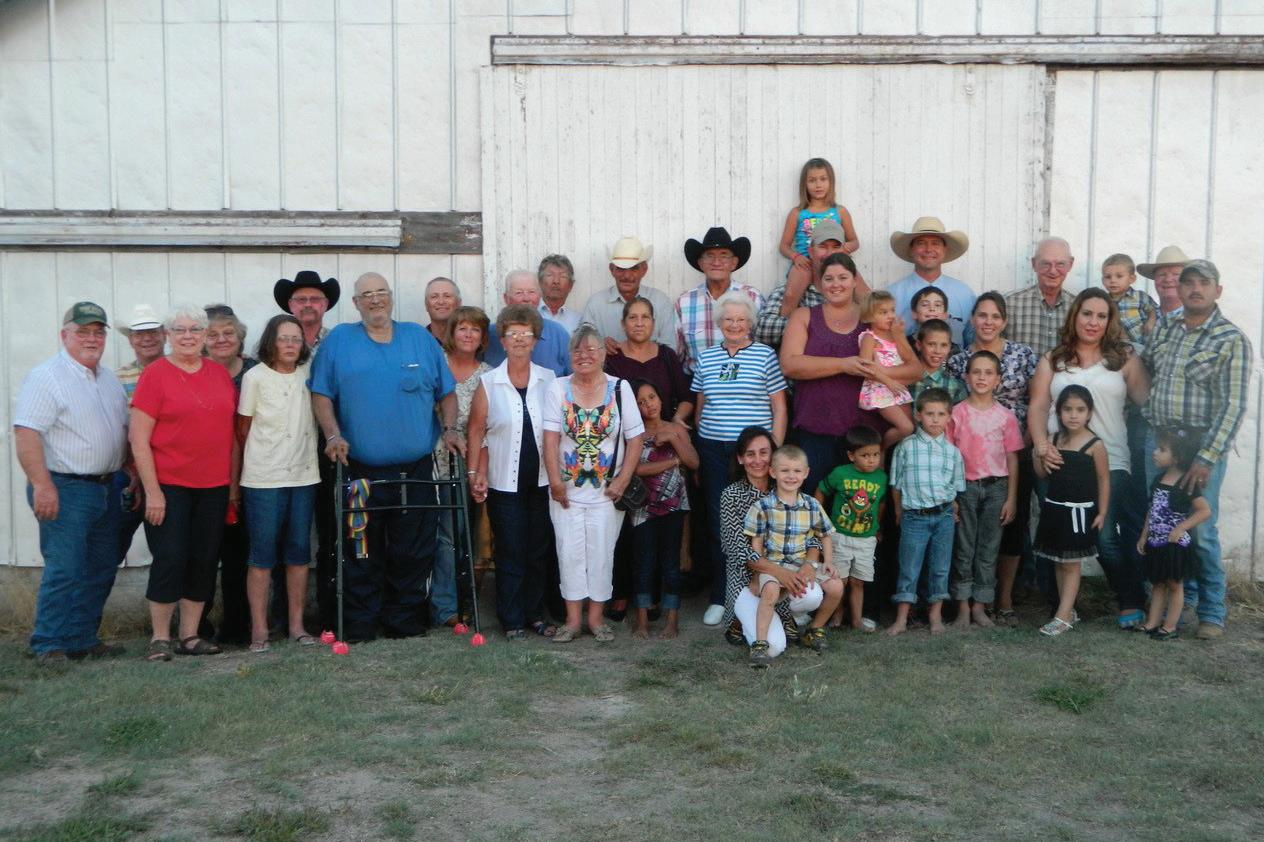
More About Maddux Cattle Company
Replacement heifers and cows are bred to calve in April and May on native range, and graze through summer and early fall with calves at side. Come fall, calves are weaned from first calf heifers and backgrounded or winter grazed, while mature cowcalf pairs are winter grazed on leased cornstalks from November through mid-March. These lactating females are supplemented. Pairs are then driven back to the ranch roughly one month prior to calving and 11-month-old calves are weaned.
With this system, the Maddux’s dry cows and most calves have year-round grazing with no hay or supplement fed. Some strategic protein supplementation is used for first-calf heifers pre-calving and pre-breeding.
The 11-month-old weaned steer calves graze through the spring and summer on leased acres and are marketed off grass each August as 900-pound yearlings. At weaning, nearly 100% of home raised heifers are retained for replacements, along with select bull prospects.
Home raised sires are selected by retaining composite bulls from an elite herd of Maternalizer cows with superior records. Cows are evaluated for the following traits, with the ideal cow being: 1,150 lb. mature weight, frame score 5 or less, fault free udders, docility, fertility, polled, longevity, pigment on eye and udder, solid colored, fleshing ability, calving ease, modest early growth and milk production. The primary selection criterion for replacement heifers and the cowherd is fertility. On a 70day breeding season only the cows that conceive in the first 45 days of the breeding season remain in the herd.
The Madduxes believe that within their composite cowherd, high growth and more milk are not desired because of higher maintenance and feed costs associated with higher production. Additionally, while some emphasis is given to carcass traits, selection is primarily for fitness and convenience traits over maximum production. Maddux Cattle Company’s goal is to have every cow pregnant, calve unassisted, and raise a calf albeit at a lower weaning and yearling weights than many production systems.
Also unique to Maddux Cattle Company is a strategy that does not maintain a mature bull battery, but instead will use around 200 yearling bulls exclusively at a ratio of 15 cows to 1 yearling bull. All yearling bulls are castrated immediately after use and culled to coincide with market signals. This is done primarily to minimize the costs of maintaining a large number of mature bulls, while also capturing an economic return.

Learn more about Maddux Cattle Company at madduxcattle.com
Difference DRIVEN TO MAKE A CLASS OF 2023 –
By Emily Stribling
In May 2023, the next class of KRIRM graduates will earn their Master of Science in Ranch Management. The class of 2023 includes Bradley Donner, recipient of the Lee and Ramona Bass Endowed Fellowship; Caroline Wild, recipient of the Joe Marlin Hilliard Endowed Fellowship; and Tyler Woodland, recipient of the East Foundation Fellowship. These individuals will be joining the elite group of 50 other graduates who have earned this title over the past two decades.
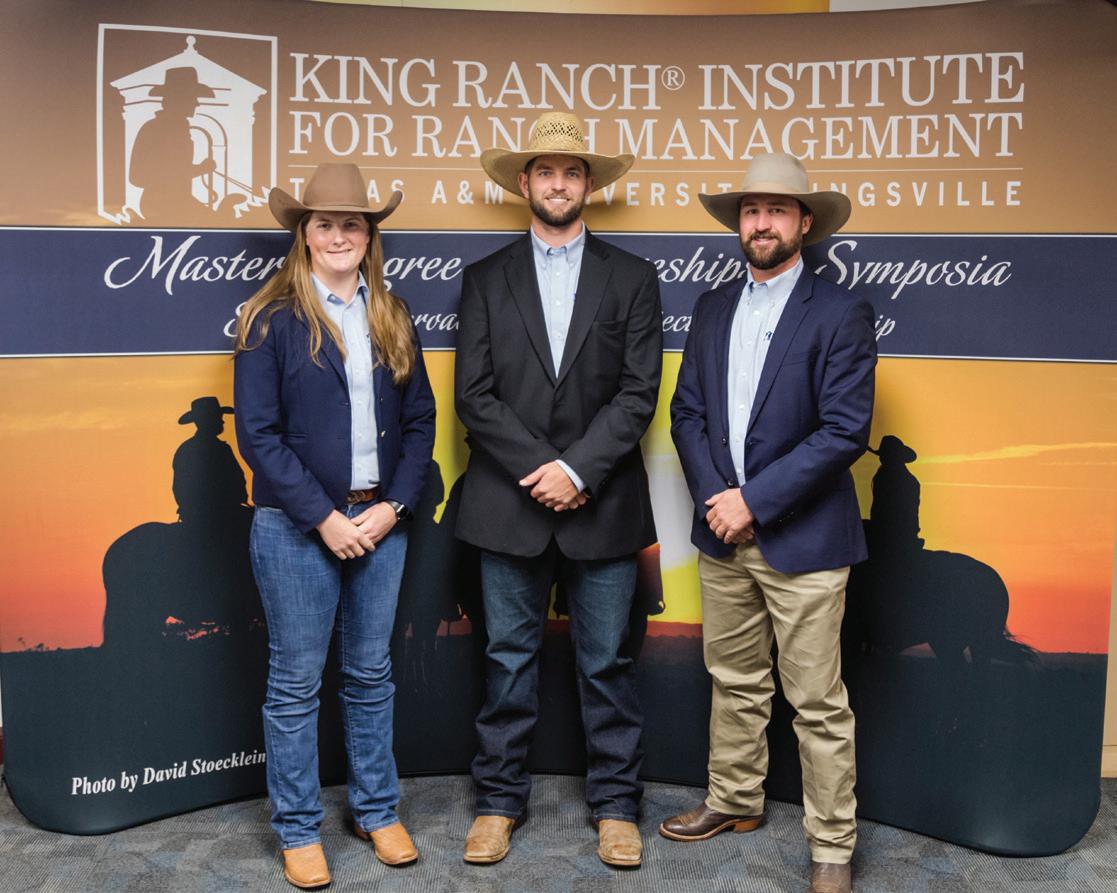
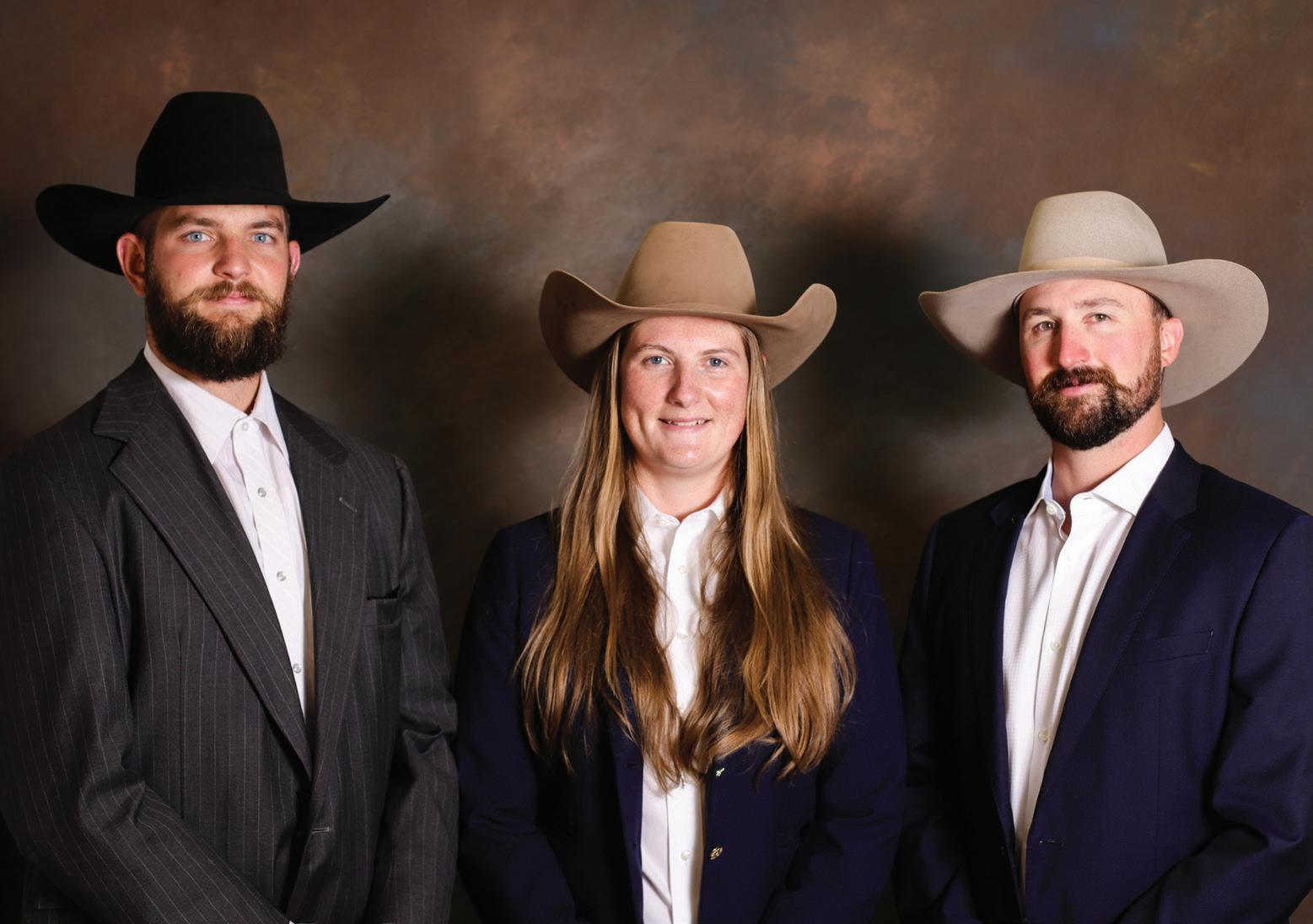
When reflecting on his experience, Tyler Woodland states, “I have enjoyed the change in perspective that I have experienced while attending the Institute. It has been interesting to take a break from the stresses of work and focus on the bigger picture of the ranching industry.”
APPLYING CLASSROOM KNOWLEDGE TO REAL-WORLD PROBLEMS
Each year, incoming students are asked what skills they hope to gain or enhance during their time in the program. Almost unanimously, the students desire to improve their understanding of accounting and financial analysis. Caroline Wild recalled she was wanting to improve her understanding of enterprise analysis and managerial accounting noting, “Ranchers often have multiple revenue streams, and it is important to be able to confidently identify profitability and calculate key performance indicators.” Courses such as managerial accounting and managerial finance provide the opportunity to learn these skills, but what really drives home the concepts are the many real-world experiences students receive through projects and case studies. When asked what he enjoyed most about the program, Bradley Donner remarks, “The opportunity to consult on multiple projects for the largest and most complex ranches in the United States. This challenged me to participate in numerous multifaceted projects incorporating an array of disciplines allowing me to gain years of experience in a condensed timeframe.”
Networking Opportunities
All three students have appreciated learning from professionals within the industry whether it be during ranch visits, industry events or KRIRM lectureships/symposia. Wild says, “Even after hearing an explanation of the program’s structure, I was pleasantly surprised at the amount of interaction with industry experts, ranch managers and other professionals; that experience significantly sets the Institute apart from any other graduate programs I considered. The Institute gave me access to subjects and people I otherwise would not have had, unlocking many new opportunities.” Woodland appreciated the opportunity to discuss goals and challenges faced by current industry leaders across the country and says, “Networking with these professionals has been inspiring and enlightening.” He also notes skills such as financial analysis, strategic planning and leadership have all been enhanced, learning from fellow peers and professors as well.
Internships
A highlight for every KRIRM student is the opportunity to intern with a partnering ranch to help solve realworld problems they are facing. Each of the students had unique experiences in parts of the country they had not previously worked.
Donner, a northern Colorado native, interned at Navasota Ranch in the Trinity River Basin near Oakwood, Texas. The ranch utilizes a high-intensity, short-term grazing system and was seeking a solution to a problem concerning the reliability and quality of their stockwater system. Donner was tasked with evaluating and designing a ranch-wide stockwater system to cost-effectively meet water demand and fulfill ownership goals. He says, “this process took significant modeling, logistics, financial analysis, and engineering to design a system that would help mitigate drought and progress the ranch towards optimization.” While he enjoyed the challenge of understanding the unique characteristics of ranching in an unfamiliar climate/geographical location, he also learned a lot about managing employees and the role they play in the success of the operation. He notes, “In order to be a successful leader, you need to cultivate followers who trust in your vision and skills.”

Wild, a Maine native, interned at Wagonhound Land and Livestock in Douglas, Wyoming. Her assignment was to identify and implement a commodity management system for their on-ranch feedlot. She remarks “It was one of the most educational (and fun) job experiences that I have had.” After researching different software systems, she purchased all the equipment needed to install the software, and created an indepth how-to guide for them to use. It was a combination of a research and human resources project. Wild remarks, “Doing this project gave me the experience to see how systems thinking is useful on a working ranch.”
Woodland, who was raised in central Nevada, interned at Sooner Cattle Company near Pawhuska, Oklahoma, a subsidiary of AgReserves. The purpose of his project was to develop a financial baseline for each class of cattle in order to determine the marginal change in profitability if that class were run at full capacity. The result of his work is a model that can be utilized and adjusted in real-time for changing input factors. The model can also be adapted for different ranches within the AgReserves system. Woodland also had the opportunity to work with employees of different units helping with daily operations. “It was a wonderful group of people to work with,” remarks Woodland. “My internship afforded me the opportunity to see the impact of a good manager, not only on the profitability and sustainability of the ranch, but on the attitude of the employees as well.”
WHAT’S NEXT?
All three are eager to put their skills and knowledge to work within the industry.
When asked about future goals, Wild notes, “I hope to provide managerial accounting and data management services to ranchers and other agricultural producers so they can keep their businesses and livelihoods strong and continue to remain a vital part of the rural landscape.”
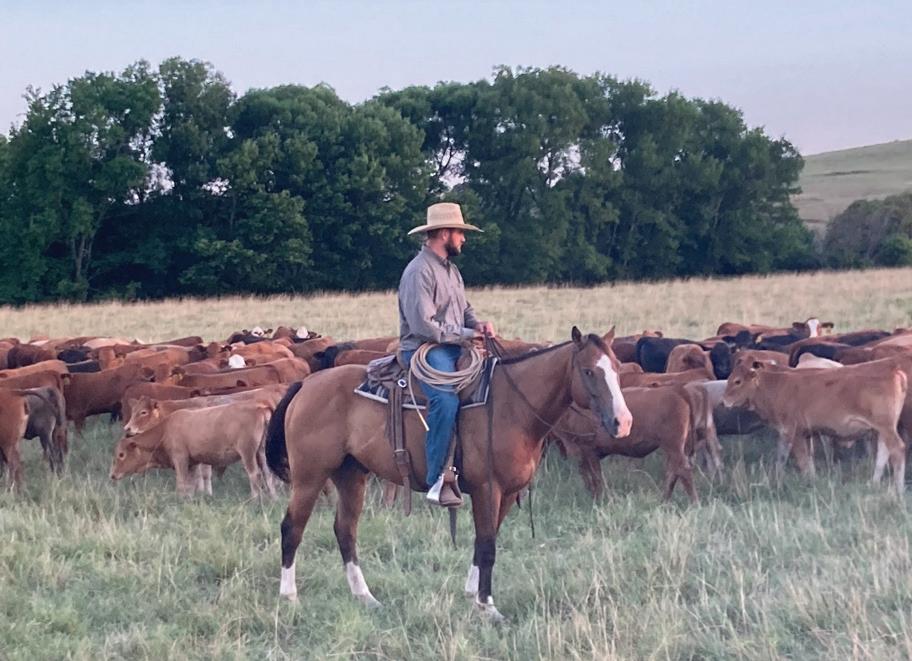
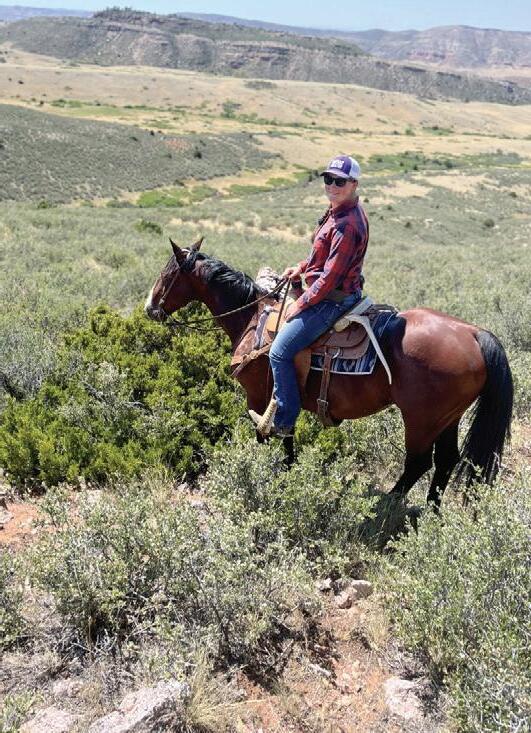
Woodland intends to apply the financial knowledge, people management skills, and business professionalism he has refined at the Institute in the ranch management arena to improve the quality and efficiency of ranch management. “I feel that traditional cowboy culture and ranching can be combined with innovative and regenerative practices to create a work environment that is appealing to employees and sustainable to the industry,” he remarks.
Similarly, Donner desires to “play a pivotal role on a dynamic and diversified ranching enterprise where I can apply my skills and knowledge leading a team to operational success while keeping true to the roots of traditional ranching by adopting innovations which have the potential to better the ranching community, land, animals and environment.”
KRIRM students appreciate learning from and networking with professionals within the industry whether it be during ranch visits, industry events or KRIRM lectureships/symposia.

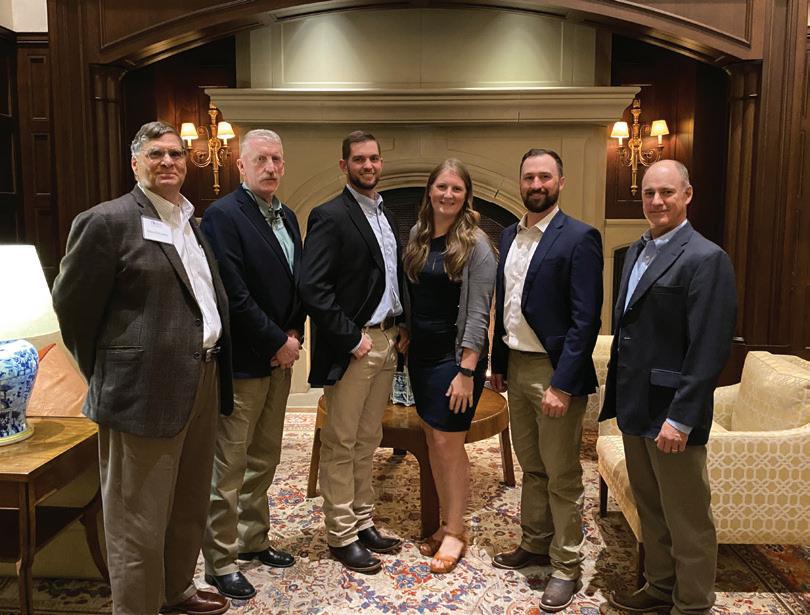
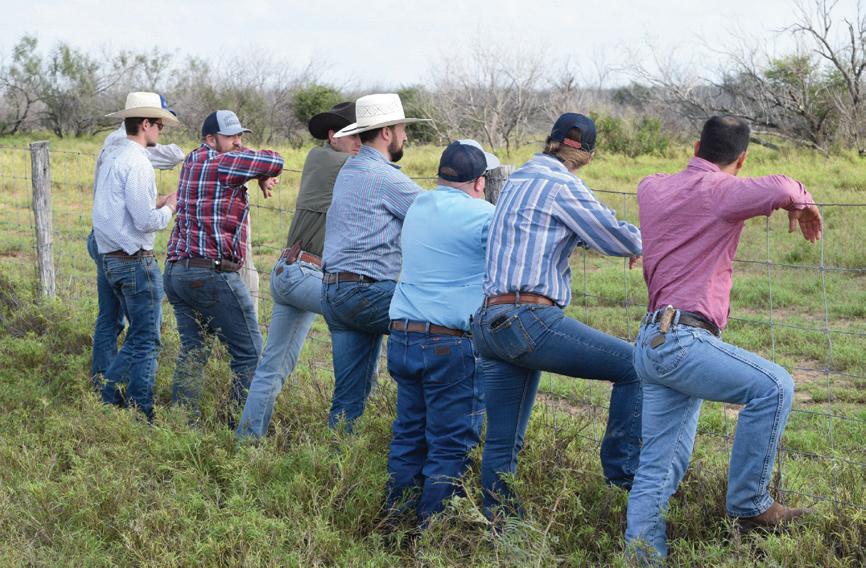
Students Share Lessons Learned and Insights Gained
With the exposure to diverse operations across the country, networking with professionals, and classroom learning, KRIRM students embrace the opportunity to learn more about current challenges facing the industry. They share some of the biggest challenges they have noticed and potential solutions going forward.
Bradley Donner says, “While there are many challenges facing the industry, one that I find particularly interesting is maintaining a ranch’s viability. I want to help generational ranches continue to be passed down to the next operator or help new owners fulfill their dreams of operating a successful agricultural enterprise. With traditional livestock ranches’ tight margins, we need to look outside the box and consider what the best use of the land’s resources are for present and future success while fulfilling ownership objectives by utilizing science, comprehensive data, accurate accounting principles and sound financial practices.
Caroline Wild remarks on the importance of continuing education, “The need to adapt to ongoing changes in the ranching industry remains a key challenge; continuing to learn through programs like the ones at KRIRM is crucial, as well as sharing information through online courses and conferences.” She adds, “As a woman in agriculture, I also feel strongly that the livestock and ranching industries should embrace the participation of women in both educational programs and management positions; this will be a crucial part of the evolution and growth of agriculture. Women are a largely untapped resource and have the potential for great contributions to our industry.”
Tyler Woodland concludes sharing a challenge he has noticed regarding a lack of sustainable land management practices in the livestock and ranching industries due to stocking rates that are too high and lack of adequate rest periods for grazed pastures. He notes, “Although lower stocking rates may decrease revenue in the short-term, it will prevent overgrazing in the future and provide a maintainable environment. There is a balance between land management and profitability that needs to be evaluated according to regional differences.”
He continues saying, “Profitability is an all-encompassing challenge. There are many different practices that can be adopted to increase profitability. As students, we have been able to learn from industry leaders at the KRIRM Holt Cat Symposium and National Cattlemen’s Beef Association how to increase profitability. It is key to keep an open mind when it comes to management practices, additional sources of revenue, risk management and other areas.”


